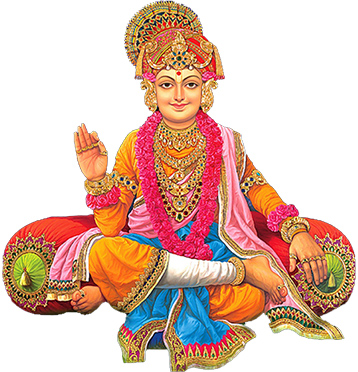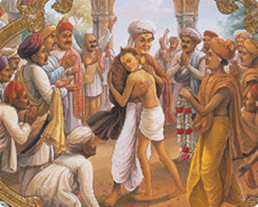
Swaminarayan Bhagwan (1781-1830 AD)
Lord Swaminarayan appeared on earth on 3rd April 1781 in the North Indian village of Chhapaiya, near Ayodhya. From the beginning, stories and experiences abound that indicated His extraordinary nature…
Nilkanth Varni
Childhood
Known then as “Ghanshyam”, by the age of seven He had already mastered the Holy Scriptures the Vedas, Upanishads, Ramayan, Bhagwatam etc.
Teenage Asceticism
When only 11 years old, He renounced his family and became a yogi. Then known as “Nilkanth Varni “, He proceeded to climb the Himalayas barefooted and perform severe austerities, such as standing on one leg and meditating in bare body amidst snowstorms for 3 months.
He then embarked, on foot, on a momentous 7-year pilgrimage of over 12,000 kilometers in His search for a spiritual guide. At the age of 18, He ultimately reached His goal by adopting Ramanand Swami as His Guru in the state of Gujarat.
Guru Ramanand Swami initiated Nilkanth as a sadhu and gave him the name “Sahajanand”.

The Swaminarayan Movement – The Beginning

Recognizing Sahajanand’s spiritual greatness and overlooking more senior sadhus, Ramanand Swami ceremoniously installed Sahajanand, at the tender age of 21, as His spiritual successor.
Soon after the death of Guru Ramanand Swami, Sahajanand gathered all of His disciples and instructed them to chant the Divine mantra “Om Swaminarayan”. By doing so, He Promised to bear their every burden and to provide them with His strength and guidance.From then onwards He was known as “Lord Swaminarayan”.
Social and Spiritual Reforms
To arrest the significant decline in social, cultural and moral standards, Lord Swaminarayan, through the Shikshaapatri (a sacred book of ethics), outlined the Hindu moral codes for everyday life. It provided practical guidance on familial, social, financial, hygienic, moral, and spiritual issues.
Lord Swaminarayan also initiated 500 ascetics, which were of the highest degree. Selfless and spiritually motivated, they practiced strict disciplines and continuously moved through society, carrying the message of purity. They helped abolish superstitions, addictions and inhumane practices such as Dudhpiti and Sati. They also dugged wells and set up alms-houses in times of famines and droughts.
His Teachings and Philosophy
The basic foundation of the Swaminarayan philosophy involves a principle called “Vishishtha Adwaitvad”. This concept stipulates that the Lord can not dwell on this earth without His Divine Abode. Lord Swaminarayan referred to Anadi Mul Akshar Murti Shri Gunatitanand Swami, a God-Realized saint who had risen above all qualities to attain oneness with the Lord, as His Abode.

Panch Vartamaan
NISHKAM – Lust – free
Lifetime celibacy
NIRLOBH – Greed – free
No possessions.
Not even to touch money
NISSNEH Attachment – free
Unattached to place, people or family
NISWAD – Taste – free
No Preference in food or taste
NIRMAN – Ego – free
Untouched by pride or anger
The Holy Scripture of the Swaminarayan faith is called the Vachnaamritam and consists of a historical collection of 262 spiritual discourses delivered by Lord Swaminarayan in the Gujarati language.
It is a catechism, filled with logic, metaphors and analogies, and divine revelations that provide philosophical and practical answers to the mysteries and questions of life.
How to overcome depression
How to identify real friends
How to calm anger
How to remove ego and jealousy
How to develop faith
How to recognize a true guru
How to realize God
Five Spiritual Vows :
![]() DO NOT STEAL
DO NOT STEAL
![]() DO NOT EAT MEAT
DO NOT EAT MEAT
![]() DO NOT TAKE ALCOHOL OR
DO NOT TAKE ALCOHOL OR
ANY INTOXICANT
![]() DO NOT COMMIT ADULTERY
DO NOT COMMIT ADULTERY
![]() DO NOT INDULGE IN AN IMPURE LIFE
DO NOT INDULGE IN AN IMPURE LIFE
The observance of these vows would purify His followers lives and prepare them for spiritual advancement. For His sadhus, Lord Swaminarayan prescribed 5 primary principles called the “Panch Vartamaan”.

